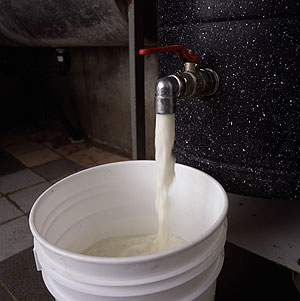Healthy Calf Conference
Follow to stay up-to-date on all Healthy Calf Conference updates. Speaker announcements, sponsorship information, registration announcements, and more.

Cold weather is stressful for calves. Those that are exposed to the cold are predisposed to respiratory tract infections (pneumonia). Appropriate nutrition and a fresh supply of water will do a lot to help them overcome stress. When calves are not fed adequately in cold temperatures, they don’t grow as quickly since they are using their energy to keep warm instead.
Ensure calves have enough bedding to keep them dry and warm. During the fall, winter and spring months, ensure you are bedding with straw, which will help to reduce a calf’s heat loss. To determine if a calf has enough straw, do the “kneel test”.
If you are unsure whether or not bedding should be changed, kneel on the bedding for 20 seconds. If your knees get wet, the bedding should be changed or added to.
The thermoneutral zone is the temperature range where calves don’t need any additional energy to maintain their body temperature. From birth until four weeks of age, this range is between 10°C and 25°C (50 – 77°F), and from four weeks to weaning, it increases to 0°C to 25°C (32 – 77°F). This means that if temperatures are outside of these ranges, calves need extra nutrition to keep warm and healthy.

The colder it gets, the more energy a calf needs to maintain heat and to keep growing. This means you must adjust your feeding program as the weather changes. A good rule of thumb is to increase the amount of milk replacer by 2 per cent for every degree the temperature falls below 5°C. When the outside temperature is 5°C, 4 litres/day at the concentration of 125g/l is starvation for a calf.
Source: Adapted from Nutrient Requirements of Dairy Cattle. Seventh Revised Edition. National Research Council, 2001, and Nutrient Requirements of Beef Cattle. National Research Council, 1996.
| Temperature°C (°F) | 50–kg calf, <3 weeks,additional milkreplacer* (L) | 50–kg calf, >3 weeks, additional milkreplacer* (L) | 75–kg calf,additional milkreplacer (L) | Weaned calves, calf starter or grain mix kg (lb.) |
|---|---|---|---|---|
| 20°C (68°F) | 0 | 0 | 0 | 0 |
| 10°C (50°F) | 0.9 | 0 | 0 | 0 |
| 0°C (32°F) | 1.8 | 0.9 | 1.4 | 0.4 (.9) |
| –10°C (14°F) | 2.7 | 1.8 | 2.7 | 0.8 (1.8) |
| –20°C (–4°F) | 3.5 | 2.7 | 4.1 | 1.2 (2.6) |
| * 20% protein, 20% fat milk replacer mixed at 125 g/L |
*Provided the calves that are dry, well bedded and kept out of drafts. If they are not, the feed requirement will be even higher in cold temperatures.
Follow to stay up-to-date on all Healthy Calf Conference updates. Speaker announcements, sponsorship information, registration announcements, and more.
The Codes of Practice are nationally developed guidelines for the care and handling of farm animals. They serve as our national understanding of animal care requirements and recommended practices.